The AMD Ryzen 3 3300X and 3100 CPU Review: A Budget Gaming Bonanza
by Dr. Ian Cutress on May 7, 2020 9:00 AM ESTCPU Performance: System Tests
Our System Test section focuses significantly on real-world testing, user experience, with a slight nod to throughput. In this section we cover application loading time, image processing, simple scientific physics, emulation, neural simulation, optimized compute, and 3D model development, with a combination of readily available and custom software. For some of these tests, the bigger suites such as PCMark do cover them (we publish those values in our office section), although multiple perspectives is always beneficial. In all our tests we will explain in-depth what is being tested, and how we are testing.
All of our benchmark results can also be found in our benchmark engine, Bench.
Application Load: GIMP 2.10.4
One of the most important aspects about user experience and workflow is how fast does a system respond. A good test of this is to see how long it takes for an application to load. Most applications these days, when on an SSD, load fairly instantly, however some office tools require asset pre-loading before being available. Most operating systems employ caching as well, so when certain software is loaded repeatedly (web browser, office tools), then can be initialized much quicker.
In our last suite, we tested how long it took to load a large PDF in Adobe Acrobat. Unfortunately this test was a nightmare to program for, and didn’t transfer over to Win10 RS3 easily. In the meantime we discovered an application that can automate this test, and we put it up against GIMP, a popular free open-source online photo editing tool, and the major alternative to Adobe Photoshop. We set it to load a large 50MB design template, and perform the load 10 times with 10 seconds in-between each. Due to caching, the first 3-5 results are often slower than the rest, and time to cache can be inconsistent, we take the average of the last five results to show CPU processing on cached loading.
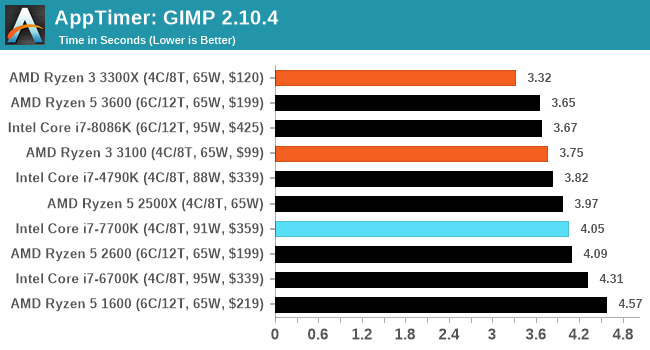
3D Particle Movement v2.1: Brownian Motion
Our 3DPM test is a custom built benchmark designed to simulate six different particle movement algorithms of points in a 3D space. The algorithms were developed as part of my PhD., and while ultimately perform best on a GPU, provide a good idea on how instruction streams are interpreted by different microarchitectures.
A key part of the algorithms is the random number generation – we use relatively fast generation which ends up implementing dependency chains in the code. The upgrade over the naïve first version of this code solved for false sharing in the caches, a major bottleneck. We are also looking at AVX2 and AVX512 versions of this benchmark for future reviews.
For this test, we run a stock particle set over the six algorithms for 20 seconds apiece, with 10 second pauses, and report the total rate of particle movement, in millions of operations (movements) per second. We have a non-AVX version and an AVX version, with the latter implementing AVX512 and AVX2 where possible.
3DPM v2.1 can be downloaded from our server: 3DPMv2.1.rar (13.0 MB)
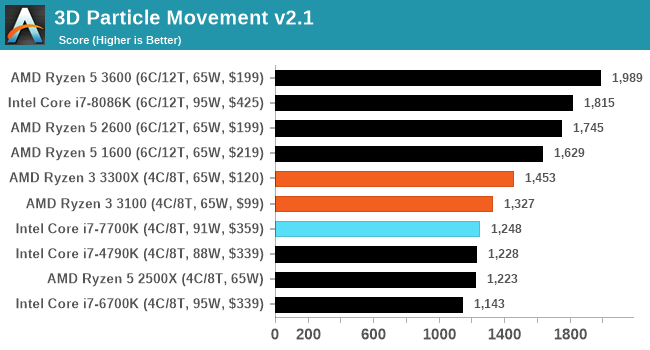
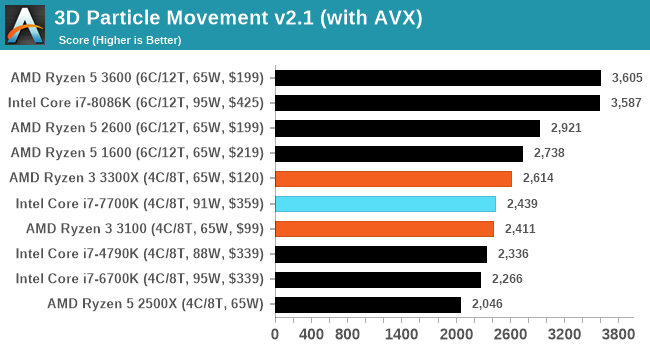
Dolphin 5.0: Console Emulation
One of the popular requested tests in our suite is to do with console emulation. Being able to pick up a game from an older system and run it as expected depends on the overhead of the emulator: it takes a significantly more powerful x86 system to be able to accurately emulate an older non-x86 console, especially if code for that console was made to abuse certain physical bugs in the hardware.
For our test, we use the popular Dolphin emulation software, and run a compute project through it to determine how close to a standard console system our processors can emulate. In this test, a Nintendo Wii would take around 1050 seconds.
The latest version of Dolphin can be downloaded from https://dolphin-emu.org/
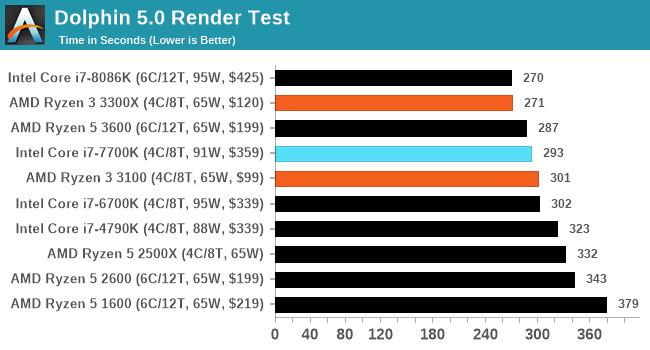
DigiCortex 1.20: Sea Slug Brain Simulation
This benchmark was originally designed for simulation and visualization of neuron and synapse activity, as is commonly found in the brain. The software comes with a variety of benchmark modes, and we take the small benchmark which runs a 32k neuron / 1.8B synapse simulation, equivalent to a Sea Slug.
Example of a 2.1B neuron simulation
We report the results as the ability to simulate the data as a fraction of real-time, so anything above a ‘one’ is suitable for real-time work. Out of the two modes, a ‘non-firing’ mode which is DRAM heavy and a ‘firing’ mode which has CPU work, we choose the latter. Despite this, the benchmark is still affected by DRAM speed a fair amount.
DigiCortex can be downloaded from http://www.digicortex.net/
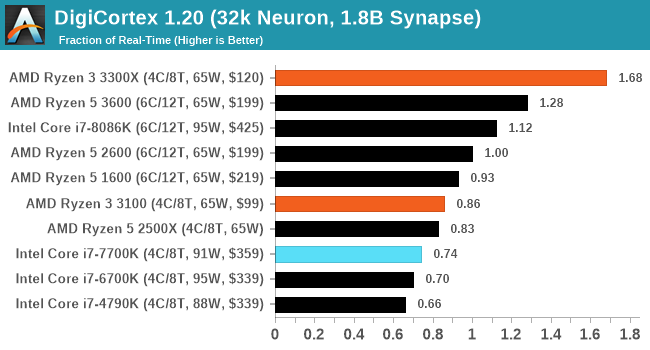
y-Cruncher v0.7.6: Microarchitecture Optimized Compute
I’ve known about y-Cruncher for a while, as a tool to help compute various mathematical constants, but it wasn’t until I began talking with its developer, Alex Yee, a researcher from NWU and now software optimization developer, that I realized that he has optimized the software like crazy to get the best performance. Naturally, any simulation that can take 20+ days can benefit from a 1% performance increase! Alex started y-cruncher as a high-school project, but it is now at a state where Alex is keeping it up to date to take advantage of the latest instruction sets before they are even made available in hardware.
For our test we run y-cruncher v0.7.6 through all the different optimized variants of the binary, single threaded and multi-threaded, including the AVX-512 optimized binaries. The test is to calculate 250m digits of Pi, and we use the single threaded and multi-threaded versions of this test.
Users can download y-cruncher from Alex’s website: http://www.numberworld.org/y-cruncher/
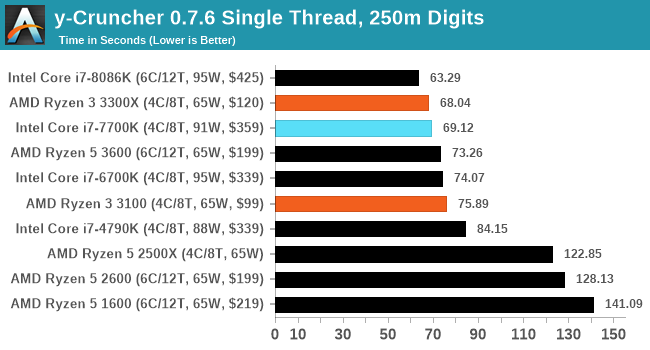
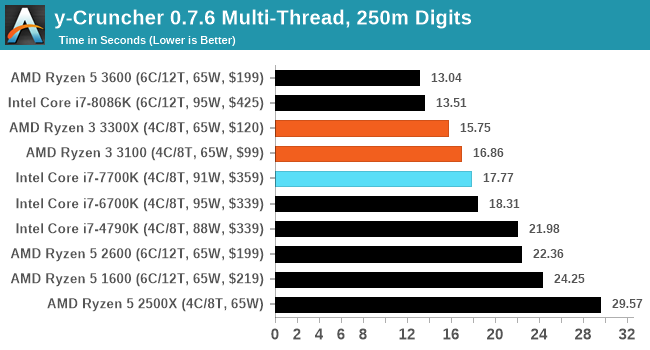
Agisoft Photoscan 1.3.3: 2D Image to 3D Model Conversion
One of the ISVs that we have worked with for a number of years is Agisoft, who develop software called PhotoScan that transforms a number of 2D images into a 3D model. This is an important tool in model development and archiving, and relies on a number of single threaded and multi-threaded algorithms to go from one side of the computation to the other.
In our test, we take v1.3.3 of the software with a good sized data set of 84 x 18 megapixel photos and push it through a reasonably fast variant of the algorithms, but is still more stringent than our 2017 test. We report the total time to complete the process.
Agisoft’s Photoscan website can be found here: http://www.agisoft.com/













249 Comments
View All Comments
destorofall - Thursday, May 7, 2020 - link
you sound butthurt0ldman79 - Thursday, May 7, 2020 - link
Heaven forbid his data set of God knows how many CPU doesn't include the one you want to see...Damn, you really should demand a refund.
LMonty - Thursday, May 7, 2020 - link
You should really file a complaint, buddy. Gotta fight for your rights. ;Pjimbo2779 - Sunday, May 10, 2020 - link
What has happened to the comments section here. Can we go back to just ignoring the ignoramus'. It often means they just go away.psychobriggsy - Thursday, May 7, 2020 - link
It was mentioned that Intel didn't even send these CPUs out for review, and that they're hard to obtain because Intel isn't making many of them.However, a few more data points would be nice. I think Ian needs to set up a system test datacentre like Phoronix so the rebuilding is kept to a minimum!
twizzlebizzle22 - Thursday, May 7, 2020 - link
AMD must have sent the 7700k or specified it's use. I've noticed every review using that specific CPU. AMD aiming for the used market upgraders it seems.amrnuke - Thursday, May 7, 2020 - link
I believe that's the last Intel chip that was 4C/8T as well, right? Seems a fair comparison, I guess if AMD really think that's the market.Anyway, TechPowerUp went ahead and lined up the 3300X against a bunch of other relevant chips (https://www.techpowerup.com/review/amd-ryzen-3-330... It's 1% slower than the 3600 at 720P gaming, 16.5% slower than the 9900K at 720P gaming.
CPU tests show the 4C/8T 3300X holding up well to the 6C/6T 8600K and 9400F. It pretty well trounces the 9100F.
The 3100 beats the 9100F by 14% in CPU tests.
schujj07 - Thursday, May 7, 2020 - link
720p gaming isn't even relevant. If these were iGPU tests then sure, but even a GTX 1050 can do better than 720p gaming.supdawgwtfd - Thursday, May 7, 2020 - link
Are you stupid?To test CPU performance you run lower resolution to ensure the CPU is the bottleneck
Your comment is not relevant.
schujj07 - Saturday, May 9, 2020 - link
Hence why most review sites use 1080p. 720p benchmarking on modern hardware is akin to Quake 3 benchmarking at 640x480 resolution back in 2000. All you end up seeing are crazy high numbers that don't mean anything. We see it all the time that CPU A is faster at 720p but then slower at 1080p?